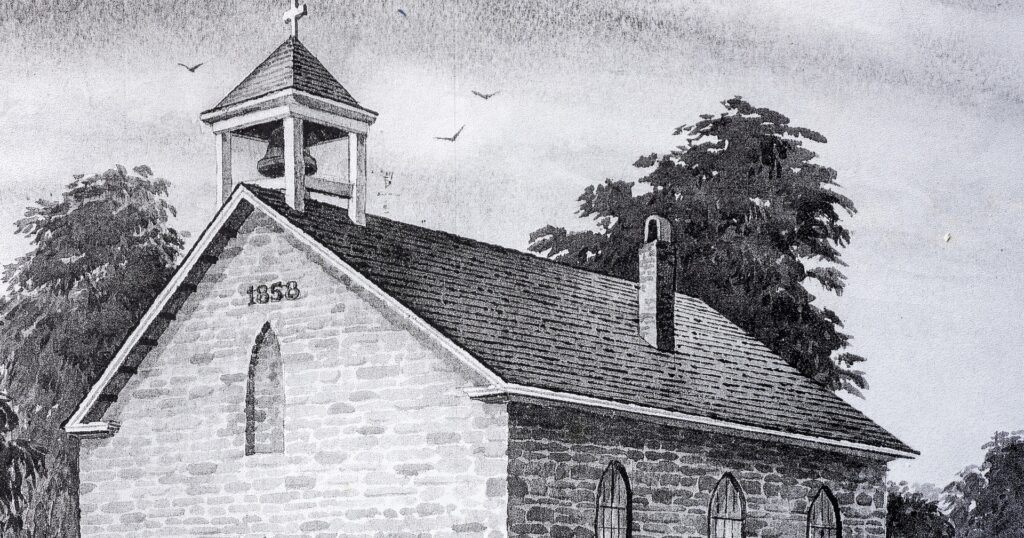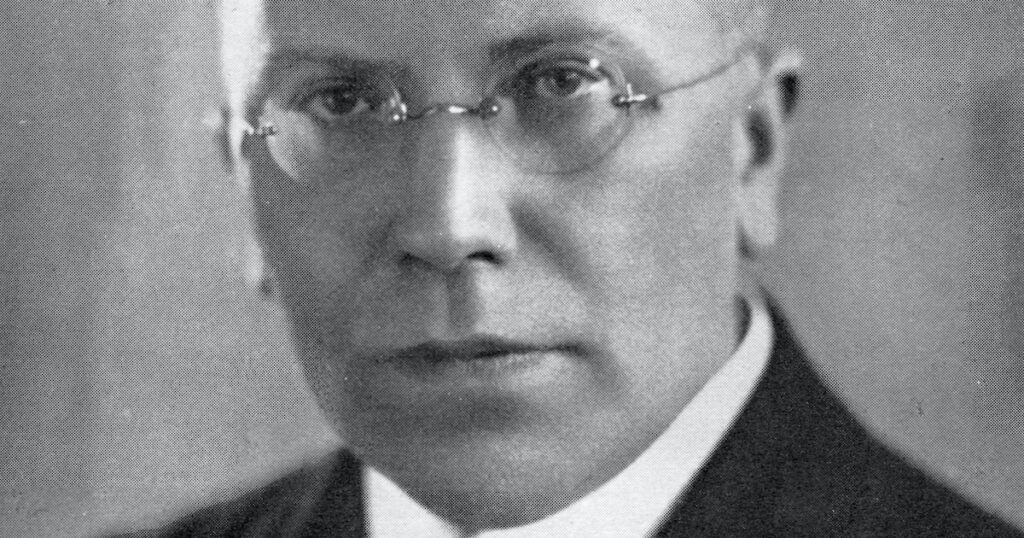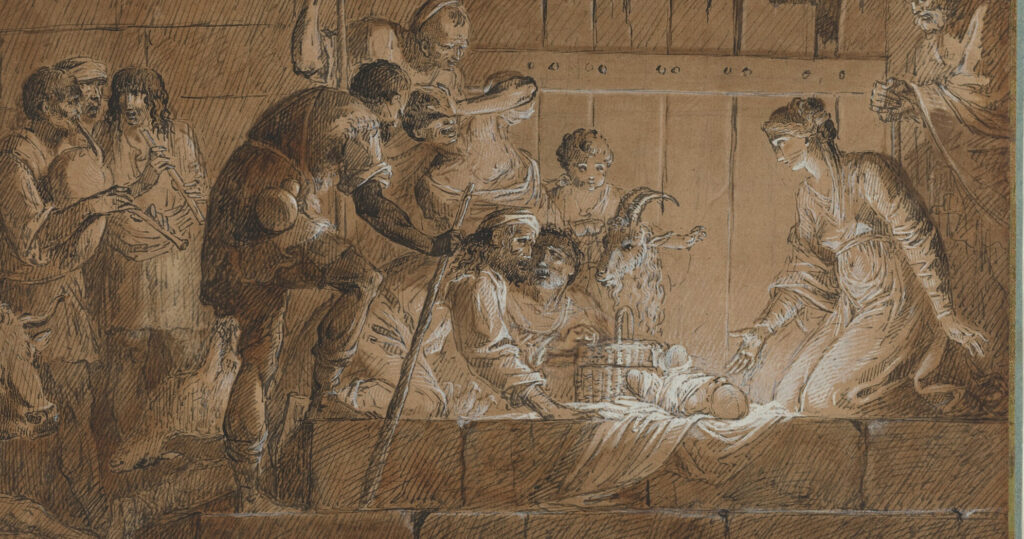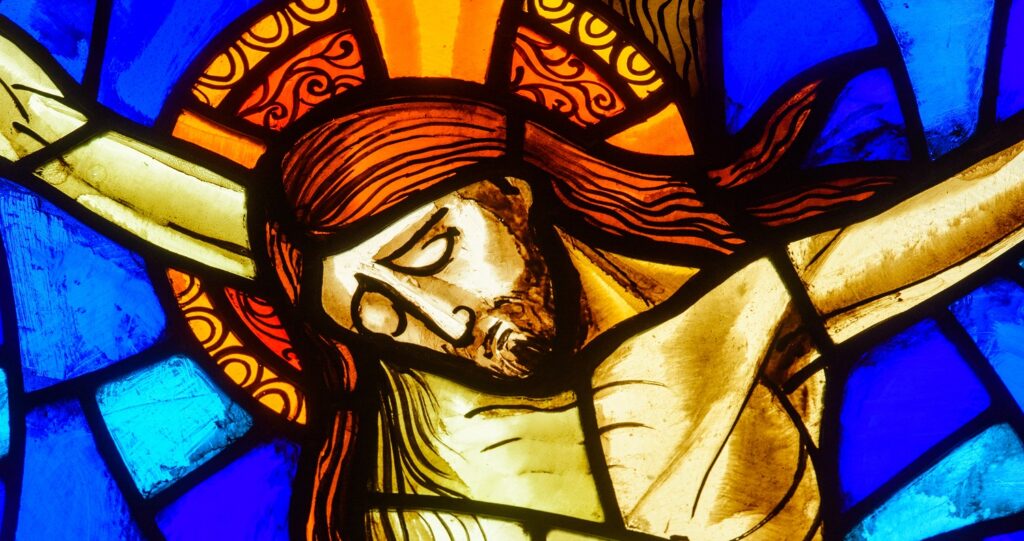FOR THE SAKE OF CLARITY AND BREVITY, we are abbreviating the church names accordingly:
✚ St. Lorenz: Evangelical Lutheran Church of St. Lorenz, Frankenmuth, Mich.
✚ First Trinity: First Trinity Lutheran Church, Buffalo (now Tonawanda), N.Y.
✚ Bingen: St. John Lutheran Church, Bingen (now Decatur), Ind.
✚ Marysville: St. John Lutheran Church, Neuendettelsau (now Marysville), Ohio
✚ New Minden: St. John Lutheran Church, Nashville (now New Minden), Ill.
✚ Bremen: St. Paul Lutheran Church, Mishawaka (now Bremen), Ind.
✚ Fort Wayne: St. Paul Lutheran Church, Fort Wayne, Ind.
✚ New Melle: St. Paul Lutheran Church, Femme Osage (now New Melle), Mo.
✚ St. Peter: St. Peter Lutheran Church, Fort Wayne (now Decatur), Ind.
✚ Trinity: Trinity Lutheran Church, St. Louis, Mo.
✚ Friedheim: Zion Lutheran Church, Friedheim (now Decatur), Ind.
✚ Schumm: Zion Lutheran Church, Schumm (now Willshire), Ohio
On April 26, 1847, representatives from 14 Lutheran congregations gathered in Chicago to sign the constitution of Die Deutsche Evangelisch-Lutherische Synode von Missouri, Ohio und andern Staaten (The German Evangelical-Lutheran Synod of Missouri, Ohio and other States). Through the work of the Rev. Friedrich Wyneken, the Rev. Dr. C.F.W. Walther and others, God brought these immigrant congregations from disparate regions of Germany to form what would become The Lutheran Church—Missouri Synod (LCMS). Wyneken was called to serve St. Paul in Fort Wayne and Zion, Friedheim; he also traveled throughout northeast Indiana, western Ohio and southern Michigan, bringing the Word and Sacraments to these pastorless frontier congregations. At least five of the 14 congregations represented in Chicago to join the Synod were influenced by Wyneken. He was known for his faithful preaching and teaching, as well as the tanned yellow leather pants that earned him the moniker “Yellow Britches.” Not far away in St. Louis, another Lutheran preacher, Walther, was guiding a group of recent German settlers through the crisis of deposing their bishop for gross sin. After the crisis, Walther and the congregation he served, Trinity in St. Louis, published a German-speaking newsletter, Der Lutheraner, that was responsible for bringing together many of the charter congregations of the Synod. For example, the members of St. John in New Minden were impressed with Walther’s writing and asked him to send them a pastor.
Of the original 14 congregations, 12 remain active congregations in the LCMS. This is the story of how God has taken these German-speaking immigrants through 175 years of preaching and teaching His Word, now in many languages and tongues.
Landfall
The charter congregations of the LCMS constitution possessed at least one commonality: They all spoke German; it was, after all, the German Evangelical-Lutheran Synod. Each church represented a group of German immigrants that had immigrated for multiple reasons
Some traveled to the United States for the sake of religious freedom. The settlers that formed First Trinity fled from the Silesia region of Germany due to the attempts of Friedrich Wilhelm III (1770–1840) to force a union between the Reformed and Lutheran churches in Prussia. This union required Lutheran churches to reject fundamental teachings of Scripture. The Saxons who traveled to St. Louis and formed Trinity Lutheran Church also left Germany for the same reason.
Other Germans migrated in search of better opportunities. John George Rausch, charter member of St. John, Marysville, Ohio, left Bavaria after almost being shot for accidentally picking up firewood on private land. He and those who left with him had not been allowed to hunt in the forests, paid high taxes, earned low wages and lived in extreme poverty. They traveled to the U.S. in search of opportunities to provide for their families.
Others traveled to the U.S. as missionary colonists. The Franconians who formed St. Lorenz in Frankenmuth (meaning, “courage of the Franconians”), Mich., were a hand-selected group of five young families, two young single men and one pastor, trained by the Rev. Wilhelm Loehe from Neuendettelsau, Bavaria. They went in response to Wyneken’s appeal to Germany for Lutheran missionaries both to preserve German-speaking immigrants in the Lutheran faith and to do mission work among Native Americans. The St. Lorenz community answered this call and purchased land in Michigan near the Chippewa tribe, in what is now Frankenmuth. The motivations for moving to the U.S. are certainly many and varied; most probably traveled to the U.S. for a combination of the reasons
The motivations for moving to the U.S. are certainly many and varied; most probably traveled to the U.S. for a combination of the reasons above, and others besides. For example, part of the interest in the young couples from St. Lorenz was also doubtless a consequence of their inability to marry in Bavaria due to restrictive marriage laws intended to prevent the bearing of children into lives of poverty. Whatever the reason, these German-speaking immigrants arrived in the U.S. and formed Lutheran congregations.
Ministry
The early Lutheran congregations in America struggled to find pastors. Many of them depended on itinerant or circuit-riding preachers who were often not Lutheran. One such “pastor” who visited New Minden admitted to being a Jew who was simply “playing pastor” to pay his bills. It comes as no surprise, then, that these young congregations quickly sought trained, Lutheran pastors to fill their pulpits.
One of the most influential of these pastors was old “Yellow Britches” Wyneken himself. The Pennsylvania Ministerium, an early Lutheran church body in America, sent Wyneken to the Fort Wayne region as a missionary to gather and care for Lutherans in northeastern Indiana. When he arrived, however, he quickly saw the need for regular pastoral care and asked to be released from his call as missionary to serve as pastor of St. Paul in Fort Wayne and Zion Friedheim. While he served these congregations, he also traveled extensively and cared for Lutheran settlements in Schumm, Bingen and St. Peter, along with many other locations.
The pastors of these early congregations often served in trying situations. The Rev. John Adam Ernst, a German cobbler who also answered Wyneken’s call for pastors, accepted a call to serve in Marysville. The congregation could not, at first, afford to pay him; instead, he lived among the members, and they provided for his needs from their own supply. The church at New Minden provided a parsonage for their pastor by erecting a wall in the sanctuary and giving the newlywed couple, the Rev. C.F.W. Scholz and his bride, a 12-by-20-foot portion of the sanctuary as a home. It was also not uncommon for pastors to die early and young. The Rev. Jesse Hoover, first pastor at Fort Wayne and Friedheim, died after only one year of service; the Rev. O.H. Walther, brother to C.F.W. Walther, died after only two years of service at Trinity; and the Rev. J.W. Burger, first pastor of Schumm, died having served less than 12 months. The living conditions and arduous travel took their toll.
Education
The pastors provided spiritual care for their people, but they also provided, in many of these young congregations, the educational services for the community. Every one of the 12 remaining charter congregations either founded a school concurrently with the congregation or started one soon after. Currently, eight of the remaining 12 congregations either still have a school or participate in a shared, cooperative school with other LCMS congregations.
Wyneken strongly believed in the importance of education being provided by the congregation; it is no surprise, then, that St. Paul in Fort Wayne has the oldest, continuously operating school in Indiana. Others such as Trinity began schooling on the boat trip over to St. Louis and continued educating their youth in the sanctuary when it had been built.
It was not until these congregations had become more established, typically in the 1860s and following, that they were able to support a teacher alongside their pastor. As with the parsonage, the churches also often provided a teacherage.
Building
The education of the young not only took place in a classroom or a dual-purpose frame church, but the children also learned from the buildings constructed by their families and fellow congregation members; one might call it an education in stone and glass. This teaching occurred along two lines: first in the way these church buildings were constructed, and second in the content of their construction.
The early settlers prioritized the construction of a church. They often donated materials, land and labor. Church members built the original church building at New Minden on 55 acres of land donated by a congregation member. The settlers had to traverse a frozen river to harvest the wood for the wood frame building. The second church, in which they still worship to this day, was built in 1863 during the Civil War. Members quarried the stone themselves and hauled it the one mile from the mine to the construction site. The owner of the mine was a member and donated the stone.
Other times, organizations within the church taught by what they provided for the church. The Ladies’ Aid society of Bingen was given permission to purchase a crucifix and candlesticks for the newly-renovated church building in 1878. Most of the charter congregations had such organizations that provided for the needs of the church.
Members also taught their children by how they provided for the church. Trinity built the church building in which they currently worship in 1865 for the fabulous sum of $113,000. Members of Trinity mortgaged their homes to provide funds for the church they loved.
Providing for the church through congregational labor is not solely the work of a bygone era. Not only did the congregation in Bremen lift their former church building and dig a basement by hand in 1946, but the current church building, finished in 2003, was constructed largely through the volunteer work of members and Laborers For Christ. In the early 2000s, Friedheim decided to purchase a slate roof for the congregation at the cost of nearly $300,000. Members donated their time and efforts in constructing a corn maze for three years in a row; the corn maze paid for the entire roof.
The contents of these churches also taught. Many congregations purchased organs to teach the children of God through Lutheran hymnody. In New Melle, the congregation still uses the Pfeffer organ purchased in 1870, the only Pfeffer organ still in regular use in the U.S. Others, such as St. Lorenz, installed stained-glass windows that teach not only the Scriptures, but also how God has worked through history in the Christian church and the congregation of St. Lorenz.
The Word
The language of these peoples was German, as seen clearly in the title of the first church body. For many of these churches, instruction and preaching in German lasted well into the 20th century. Friedheim had regular German-speaking church services until 1985, and St. Lorenz still has German services once a month. The transition to English came only with difficulty and struggle, largely the result of public sentiment during World War II. But as we look at the history of these 12 congregations, it is clear that the German language, vigorous pastors, fancy church buildings or rigorous schools do not make the church.
It is, rather, the Word that makes the church, specifically, the Word made flesh, Jesus Christ. The faithful Lutheran pastors who traversed wilderness and braved dangerous roads and weather did so to bring the Word to God’s people. The church buildings made of stone and glass point both in their content and construction to the Cornerstone upon which the entire church is built, the confession of Jesus Christ. And all the teaching done in Lutheran churches over the last 175 years has succeeded only when and where it has pointed to Christ and Him crucified for the sins of the world. Whether in the words of Der Lutheraner or in the preaching of Wyneken, it is always and only Christ.
FACTS AND FIGURES
About the charter congregations of the LCMS
The founding constitution of The Lutheran Church—Missouri Synod (LCMS) lists the signatures of representatives from 14 charter congregations. Here are some interesting facts on 12 of these congregations. Two of them only remained in the LCMS for a short time and no longer exist.
1 First Trinity Lutheran Church, Buffalo (now Tonawanda), N.Y.
✚ The congregation was formed by a group of Silesian immigrants who arrived in Buffalo, N.Y., on Sept. 6, 1839.
✚ The first pastor of the congregation, the Rev. Ernst Moritz Buerger, represented First Trinity at the first convention.
✚ In 1873, the Lutheran Young Men’s Association of First Trinity established the first lending library in Buffalo, N.Y.
✚ The charter meeting of the International Walther League on May 23, 1893, was hosted here.
2 St. John Lutheran Church, Bingen (now Decatur), Ind.
✚ The first church record is the burial of Christian Oetting on Dec. 23, 1845.
✚ The school was formed with the church and continues to this day as a joint school with two other congregations.
✚ In 1942, St. John began offering English services permanently.
✚ The building St. John currently worships in was dedicated on May 4, 1879; it cost $8,838.59.
3 St. John Lutheran Church, Neuendettelsau (now Marysville), Ohio
✚ On the trip over, the founding members were almost shipwrecked. For many years, the congregation celebrated the Schiffbruchgottesdienst (shipwreck thanksgiving festival) commemorating how God delivered them.
✚ The church dedicated its first log-cabin sanctuary on Pentecost 1838.
✚ The first pastor, the Rev. John Adam Ernst, was a former cobbler who answered Wyneken’s call for pastors to be sent to America.
✚ The congregation split in 1846 over lax views toward dancing and drinking, but rejoined in 1878.
4 St. John Lutheran Church, Nashville (now New Minden), Ill.
✚ St. John was founded on Nov. 8, 1846, and called its first pastor, Candidate Carl. F. Scholz.
✚ The congregation’s third pastor, the Rev. M. Eirich, served 33 years, baptized 1,772 children, confirmed 1,223 people, married 467 couples and officiated at 933 burials.
✚ The second church building, in which the congregation currently meets, was built during the Civil War in 1863; since its dedication, it has suffered significant damage from three different tornados, most recently in 2013.
5 Evangelical Lutheran Church of St. Lorenz, Frankenmuth, Mich.
✚ Inspired by Wyneken’s appeal for pastors, the Rev. Wilhelm Loehe sent this group of Lutherans to be a missionary colony amongst the Native American tribes in Michigan.
✚ The first pastor, the Rev. August Craemer, knew both German and English. He learned the Chippewa language to preach the Gospel to the Chippewas who lived nearby.
✚ It is believed that the chief of the local Chippewa tribe asked Craemer to “teach my people the truth.”
6 St. Paul Lutheran Church, Mishawaka (now Bremen), Ind.
✚ The congregation formed on the same day as the installation and ordination of its first pastor, the Rev. G.K. Schuster, on Oct. 14, 1846.
✚ In 1875, the congregation voted to disallow chewing tobacco in church. Anyone chewing tobacco was to spit it in the receptacle in the narthex.
✚ In 1946, the members of the congregation lifted the church and dug out, by hand, a new basement.
7 St. Paul Lutheran Church, Fort Wayne, Ind.
✚ The congregation was founded in 1837, and the first pastor, the Rev. Jesse Hoover, died in 1838.
✚ In 1838, the Pennsylvania Ministerium sent Wyneken to Fort Wayne as a missionary. He quickly requested to be released from that call to serve St. Paul, Fort Wayne, and Zion Friedheim full time.
✚ One of the drafts of what would become the LCMS constitution was written at St. Paul during Wyneken’s tenure.
✚ Every Christmas Eve, the congregation still sings “the Ungemach,” a piece of antiphonal Christmas music written by a former teacher from the turn of the century named John Ungemach.
8 St. Paul Lutheran Church, Femme Osage (now New Melle), Mo.
✚ Originally from the Melle region of Lower Saxony, these Saxons arrived in America around 1839 but did not formally organize as a church until 1844.
✚ In 1858, the congregation built the current building in which they now worship; they renovated it in 2009.
✚ They learned of C.F.W. Walther through Der Lutheraner and asked him to send them a pastor, which he did: the Rev. Carl Herman Fick.
✚ In 1935, the congregation finally removed the hitching posts from the church because most members owned cars.
9 St. Peter Lutheran Church, Fort Wayne (now Decatur), Ind.
✚ The first Lutheran settler, Clamor Fuelling, moved into the area around 1837.
✚ Wyneken visited and preached at Fuelling’s home until a congregation was formally established in 1841.
✚ Their first full-time pastor was the Rev. F.W. Husmann.
✚ The congregation continued German services until 1966; in 1969, St. Peter’s school combined with Immanuel.
✚ Due to issues with the old building, St. Peter built a new church that was dedicated in 1970.
10 Trinity Lutheran Church, St. Louis, Mo.
✚ The Saxons arrived in St. Louis on Feb. 19, 1839; the Rev. O.H. Walther was installed as pastor of this congregation.
✚ After O.H. Walther died, his brother C.F.W. Walther accepted the call to serve Trinity in 1841.
✚ Trinity helped launch Der Lutheraner in September 1844.
✚ The current church building was dedicated on Dec. 4, 1865, and constructed at the cost of $113,000, an enormous sum of money at the time. Members of the congregation mortgaged their own homes to defray the costs.
✚ In 1926, the congregation built a hall for the youth in the basement that included a bowling alley, a common feature in Lutheran church basements at the time.
11 Zion Lutheran Church, Friedheim (now Decatur), Ind.
✚ The name “Friedheim” was reportedly given to the congregation by Wyneken and means “house of peace.”
✚ The congregation was founded on Feb. 25, 1838; the Rev. Jesse Hoover, who traveled the 16 miles between Zion Friedheim and St. Paul, Fort Wayne, on horseback, died a year after serving both congregations.
✚ Wyneken became pastor of the congregation after Hoover and married Sophie Buuck, a daughter of the Zion Friedheim congregation.
✚ In the early 2000s, the congregation added a slate roof to the church at the cost of around $300,000. The congregation raised the funds through a corn maze fundraiser from July to October for three consecutive years.
12 Zion Lutheran Church, Schumm (now Willshire), Ohio, and St. Paul Lutheran Church, Liberty Township, Ohio
✚ At the founding of the LCMS, St. Paul and Zion were a dual parish; St. Paul eventually joined the American Lutheran Church and became a member of the Evangelical Lutheran Church in America (ELCA).
✚ In 1838, John George Schumm set aside ground for the church and cemetery that became Zion, Schumm.
✚ The first seven years, Wyneken served the congregation as part of his regular circuit.
✚ In 1946, the congregation resolved to have all services in English, with German upon request.
PLEASE VISIT lcms.org/175 to learn more about the LCMS’ 175th-anniversary celebrations. Over the next six months, we will post stories focused on each of the remaining 12 charter congregations of the LCMS.






I ended up on this site by chance. I was baptized into LCMS 1953 St Paul’s Lutheran Church, Ft. Wayne, Indiana. Went to St Paul’s Lutheran school and every Christmas performed the Ungemach with the Rev E. Nerger as cantor. I am looking for possible music from the years 1958-1968 from that time. u-tube maybe?
I attended Concordia Lutheran HS 68-72 and was a member of the A’ Capella choir and performed at St Lorenz in Frankenmuth, Michigan.
Great memories that live with me to this day.
did C F Walther travel through northwest Ohio ? on the miami erie canal.
A very good article with lots of interesting information. Sometimes histories about the LCMS focus on just Walther and the Saxons, but this article does a good job of showing how important Wyneken and the Loehe “sendlings” were.
As important as Wyneken was, he wasn’t present at the meeting at St. Paul’s, Fort Wayne, during the summer of 1846 when a draft constitution for the synod was written. In 1845 old “Yellow Britches” had accepted a call to a congregation in Baltimore, MD (that would rename itself St. Paul’s). The pastor at St. Paul’s, Fort Wayne, in 1846 was Rev. Wilhelm Sihler, who was also instrumental in the formation of what is now the LCMS.
What were the names and location of the other 2?
Rev. Georg Burger served two congregations in NW Ohio – Zion, Schumm, in Van Wert County and St. Paul’s in Liberty Township of neighboring Mercer County. After Burger’s death just a month before the April 1847 meeting in Chicago, Rev. J.G. Streckfuss represented the two congregations as they joined the synod. St. Paul’s later left the LCMS and is now a member of the ELCA.
According to the Concordia Historical Institute’s website, the Lutheran congregation(s) at Peru, Illinois is/are no longer in existence.
https://concordiahistoricalinstitute.org/about-chi/chi-reference-and-research/frequently-asked-questions/charter-members-of-the-missouri-synod/
Thank you for the wonderful and educational article about the history of the Synod. A few years back my family made the journey from the West Coast to attend Easter Service at St. Lorenz. The stained glass really was awe-inspiring and the more time you looked at it the more history you saw. It was also educational to explain to my kids how we made the trip across the country in a day, whereas the founding members’ journey from Germany took many months after many more months of preparation.
I am always interested to read about the LCMS history, since my ancestors also came from Germany to seek religious freedom. I had the opportunity to visit the church in Frankenmuth, but was not there for a Sunday service. Also, I was on a bus tour that went to Missouri to see the first (very small) Lutheran Seminary. There were so many unique facts in your article. Looking forward to more information in this 175th year celebration!
I’m familiar with St. Lorenz in Frankenmuth. I knew some of the history but interesting to read about the other churches. Amazing that that the majority are still active. St. Lorenz is beautiful as are its festival services. Will make a point to visit again when I am in the area. Thanks for the article. Very interesting.
It is always worthwhile to learn more history of our churches. Great article.
Interesting!👆🙏☝Like the 12 Disciplines?!!!
My Great Grand-parents, my Grandparents and my Father were all members of St. Lorenz in Frankenmuth. Since it is less than 10 miles from Saginaw, where we now live, we often drive out there for special services. As for myself, I have belonged to 4 LCMS Congregations, here in Saginaw: Trinity (No longer in existence); Bethlehem; Good Shepherd, and Peace (currently). I, too attend grade school (1-8) at LCMS Schools (at Trinity and Bethlehem). I and my family have been very thankful for all the faithful pastors who have served us through the years. One of them, The Rev. Dr. ASndrew Zeile was the President of the Michigan District LCMS.
Very interesting and encouraging to me! Thank you for writing the article!
Awesome article!
Thanks for publishing
Wonderful history of our Synod.
This is very interesting to me.
I attended a LCMS school, grades 1-8, and one of the churches associated with the school.
Thank you for sharing this.